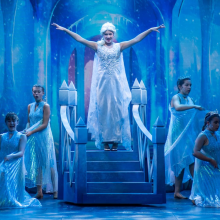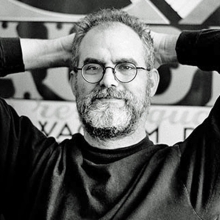Filichia Features: Randy Skinner Gives the Skinny on Choreography

Filichia Features: Randy Skinner Gives the Skinny on Choreography
Caught up with Randy Skinner before he headed to London to cast a new 42nd Street. Because we’d last met this summer at a Music Theatre International workshop for teachers, we reminisced about the two dance instructors who ran it.
“Each teacher got great results with different ways of working,” he said. “One had everything pre-arranged, all thought out. She made adjustments with the people she had, but stuck to her original plan. The other teacher gathered her dancers, improvised a lot, found the people’s strengths and worked off them.”
And which way does the four-time Tony-nominee prefer?
“Both, actually,” he said. “The important thing is to tell a story in choreography, get ideas from the lyrics -- nothing should ever get in the way of a lyric -- and to see the dancers’ actual personalities when they’re dancing.”
Skinner started his Broadway career assisting Gower Champion on the original 42nd Street. “I was 26 and still dancing. Gower said ‘You should start exploring other avenues and not be dependent on one aspect of the business.’ He saw something in me that suggested I could choreograph. But I said ‘But I’m happy dancing and performing.’”
Destiny took a hand. Champion was more ill than anyone knew until opening night of 42nd Street when producer David Merrick announced that the illustrious director-choreographer had died. Since then, Skinner has been the keeper of 42nd Street’s choreographic flame, doing the dances for two national companies, London and Australia productions as well as the 2001 Broadway revival (his second Tony nomination) and now London again. “I made the transition without planning to,” he said.
What’s he learned along the way? “When I audition dancers, I give them the most difficult technical moves that I’m putting in the choreography. It’s unfair to hire dancers without testing them on the hardest thing they’ll have to do. You don’t want to get into rehearsal and only then find out that they can’t do what you’ve had in your head. If you do hire people with limitations, you must honor their limitations. You can’t expect them to do something beyond their abilities. It’d be like hiring a baritone and expecting him to hit tenor notes.”
“Have a music rehearsal before doing any choreography,” he added. “It goes smoother when your dancers are already familiar with the song.”
Realtors say that an important selling point of any property is “location, location, location.” Skinner has his own spin on that by spinning the location when he rehearses dancers. “They can get locked into one way of movement when they’re always facing the same way. I have them face the mirror for a while, then turn them around to face the window, then the door, then the wall. It sounds odd, but it really makes them concentrate.”
The hardest thing in dance-driven shows? “Each number must have an overall arc so that it doesn’t peak in the first two minutes,” he said. “The show must have an arc, too. You must top each number and not repeat yourself or put too many of the same numbers back-to-back.”
Skinner rarely has dancers sing after they’ve done a big dance number. “It’s the old Fred-and-Ginger technique. They’d sing, dance and then be in love without singing about it again.”
Skinner loves “their nine black-and-white films” so he was thrilled to work with Ginger Rogers. “She said she could tell that I’d studied her films with Astaire. When I did Dames at Sea last year” – his fourth Tony nomination – “Eloise Kropp, our Ruby, told me how much she’d admired Eleanor Powell and I could see that style in her. So dancers should watch those old movies.”
That includes ones by Busby Berkeley -- who told his dancers “Keep doing the same dance step over and over until the audience applauds.” Skinner agrees that “It’s an exciting technique, especially if you keep adding people to the number” but feels that “you shouldn’t design a step for applause, for if it doesn’t get it, it’s like telling a joke that doesn’t get a laugh.”
The Columbus native was taking dance classes when he was four. It led to his taking tap, jazz and ballet at Ohio State University, where he got an education degree just-in-case. (He does use it, for he’s a guest teacher at such schools as Otterbein and Rider.)
And he’s a student, too – “because I still take classes. I tell everyone to. When your opportunity comes, you must be ready.”
You may e-mail Peter at pfilichia@aol.com. Check out his weekly column each Monday at www.broadwayselect.com and Tuesday at www.masterworksbroadway.com. His book, The Great Parade: Broadway’s Astonishing, Never-To-Be Forgotten 1963-1964 Season is now available at www.amazon.com.

























